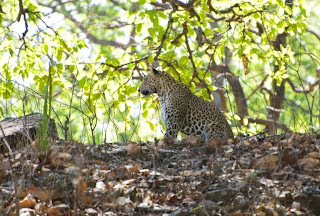
Mr.Kalyan Verma Famous wildlife photographer is organizing a 4 DAYS workshop on Wildlife Photography at The Celebration Van Vilas (Luxury Wildlife Resort) of Kanha and Bandhavgarh Tiger Reserve, Madhya Pradesh, from 14th to 17th Nov 2009 at Kanha and 17th to 20th Nov 2009 Bandhavgarh.
Kanha National Park is spread into 1945 sq km, Kanha support one of the largest populations of the tigers in the country and some of the other larger animal species found in the park are sloth bear, leopard, spotted dear, wild boar, jungle cat, Dholes (Wild Dogs), Gaur (Bison) and a variety of monkeys like Macaque, Langurs etc.
The only National Park in the world to spot Hard Ground Barasingha (Swamp Deer) in wild.
Bandavgarh National Park is having highest density of Tigers in the world. Bandhavgarh National Park is not only famous for tigers it is also famous for its historic (oldest fort) and landscape.
Kanha and Bandhavgarh supports Over 200 spices of birds have been spotted in the park.
This particular workshop will provide immense opportunity to the participants to enjoy nature in its epicenter and splendid opportunity of wildlife and nature photography.
The participants are requested to bring their equipments for the same including camera body, lenses, tripods and enough batteries and storage devices.
The following is the schedule of the tour.
14.11.2009 – Arrive at The Celebration Van Vilas, Kanha National Park by 2:00 PM followed by Lunch.
At 4:00PM Introduction session will be organized among Participants and Mr.Kalyan Verma, later followed by brief description on Kanha National Park.
Dinner at 8:00 PM
15.11.2009 – 5:00 AM wake up call followed by Tea at Restaurant, leave for Morning game drive inside the Kanha Tiger Reserve, breakfast inside the core forest of Kanha.
At 12:00 PM photography seminar will be organizes, followed by lecture by Mr.Kalyan Verma.
Lunch at 1:30PM
At 2:30 PM leave for evening game drive
Dinner at 8:00 PM
16.11.2009 – 5:00 AM wake up call followed by Tea at Restaurant, leave for Morning game drive inside the Kanha Tiger Reserve, breakfast inside the core forest of Kanha.
At 12:00 PM photography seminar will be organizes, followed by lecture by Mr.Kalyan Verma.
Lunch at 1:30PM
At 2:30 PM leave for evening game drive
At 7:00PM lecture by Mr.Shivaji Chavan Sr. Landscape Coordinator of WWF
Dinner at 8:00 PM
17-11-2009 – 5:00 AM wake up call followed by Tea at Restaurant, leave for Morning game drive inside the Kanha Tiger Reserve
After Lunch Leave Kanha For Bandhavgarh National Park (5 hours Drive) Return back
Arrive at The Celebration Van Vilas, Bandhvagrah National Park
At 5:00PM Introduction session will be organized among Participants and Mr.Kalyan Verma, later followed by brief description on Bandhavgarh National Park.
Dinner at 8:00 PM
18.11.2009 – 5:00 AM wake up call followed by Tea at Restaurant, leave for Morning game drive inside the Bandhavgarh Tiger Reserve, breakfast inside the core forest of Bandhavgarh
At 12:00 PM photography seminar will be organizes, followed by lecture by Mr.Kalyan Verma.
Lunch at 1:30PM
At 2:30 PM leave for evening game drive
Dinner at 8:00 PM
19.11.2009 – 5:00 AM wake up call followed by Tea at Restaurant, leave for Morning game drive inside the Bandhavgarh Tiger Reserve, breakfast inside the core forest of Bandhavgarh
At 12:00 PM photography seminar will be organizes, followed by lecture by Mr.Kalyan Verma.
Lunch at 1:30PM
At 2:30 PM leave for evening game drive
Dinner at 8:00 PM
20.11.2009 – 5:00 AM wake up call followed by Tea at Restaurant, leave for Morning game drive inside the Bandhavgarh Tiger Reserve, breakfast inside the core forest of Bandhavgarh.
Back to the resort and after lunch free for onward journeys.
Cost:
The cost of all-inclusive safari either at Kanha or Bandhavgarh is Rs 14,800 per person (but not inclusive of travel till the National Parks). The same rate applies for each participant regardless of whether they are doing photography and participating in the safari, or not.
If you choose to participate in both the safaris together, the all-inclusive trip (including drop between Kanha and Bandhavgarh) will cost Rs 27,800
Accommodation is two persons to a room. If you wish to have a private room (single occupancy) there will be a supplementary charge of Rs 3000










